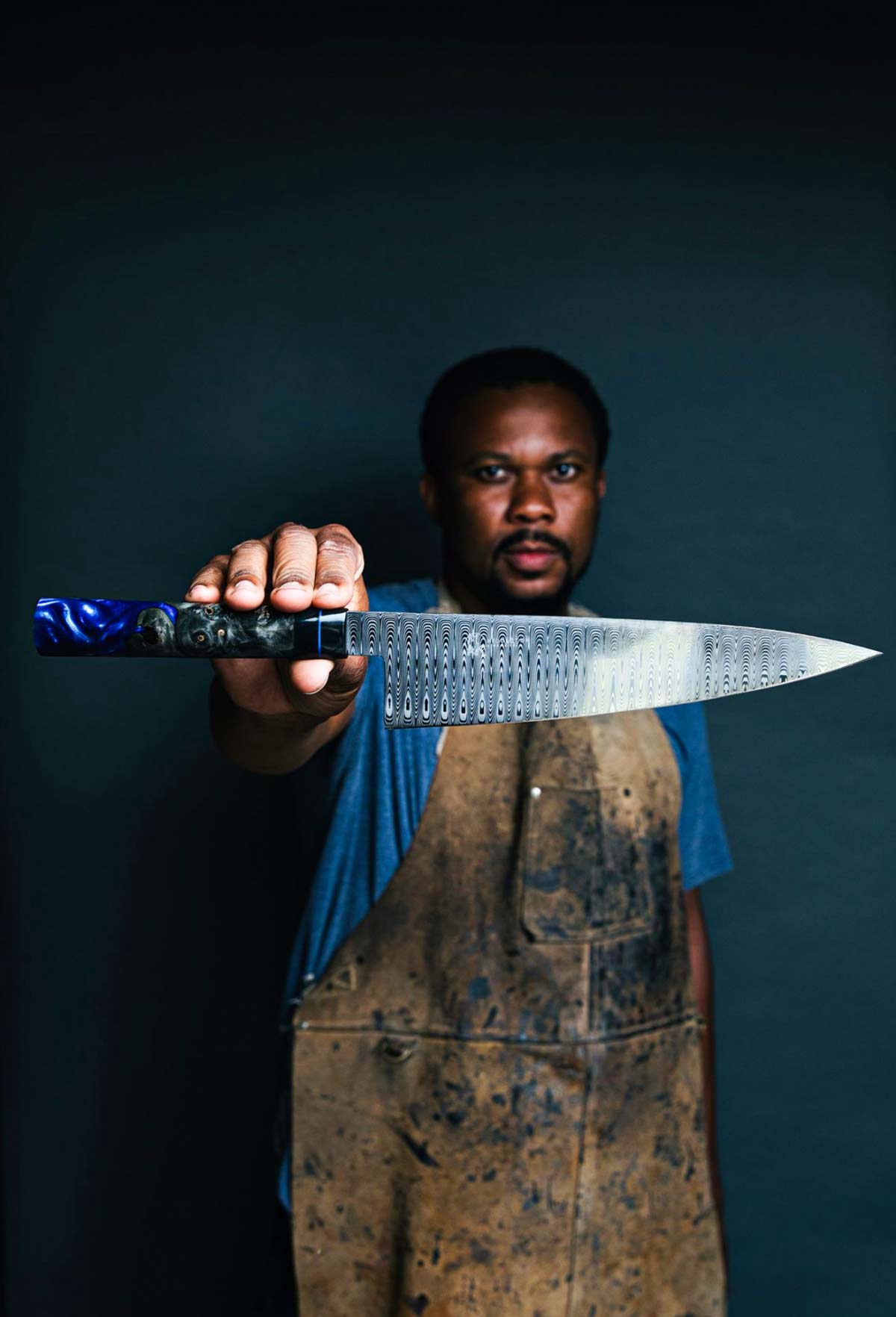
SUBSCRIBE ON Apple | Spotify | Sticher | Amazon | Google | iHeart | TuneIn
Contents
- Chat with us
- Transcript
- Quinton Middleton
- When did you know you wanted to make knives?
- How divine intervention played a role in Quintin’s calling
- Persistence and practice make a dream career happen
- How do you make those crazy gorgeous handles on your knives?!
- And then there are those exquisitely designed blades…
- The real story behind the man who makes the knives
- Recipes on LC’s specials board this week
- Oops…OUTTAKES!
☞ If you like what you hear and want to help support us, even $1 will help! Thank you.
SUBSCRIBE ON Apple | Spotify | Sticher | Amazon | Google | iHeart | TuneIn
☞ If you like what you hear and want to help support us, even $1 will help! Thank you.
Have a question, query, or quagmire you’d like Renee and David to answer? Click that red button to the right, or click on this link to leave us a recorded message. Press and talk away and maybe you’ll be featured on the show!
There are few tools as significant to a cook of any caliber than a knife. So much so that some of us (moi) hoard them, which is easy to happen given the options available for each kitchen task.
Others of us (The One) quietly rely on a single, more utilitarian knife that’s easy on the budget and keeps things simple in the kitchen. Yet few of us, perhaps, ever consider the craftmanship that some few knifemakers express through their creations, offering us knives that are as much an expression of art as they are a means of slicing, dicing, and mincing.
Here to share his talent and his story is entrepreneur Quintin Middleton, who apprenticed under a renowned knifemaker for years as he learned metalworking and the whys and hows of making a handle from wood, and then studied in chefs’ kitchens to better understand the specific qualities a knife needs to possess to be indispensable.
What came after that can only be explained as inspired. Perhaps divinely so.
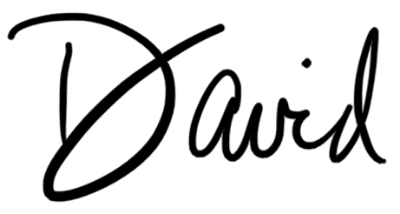
Chat with us
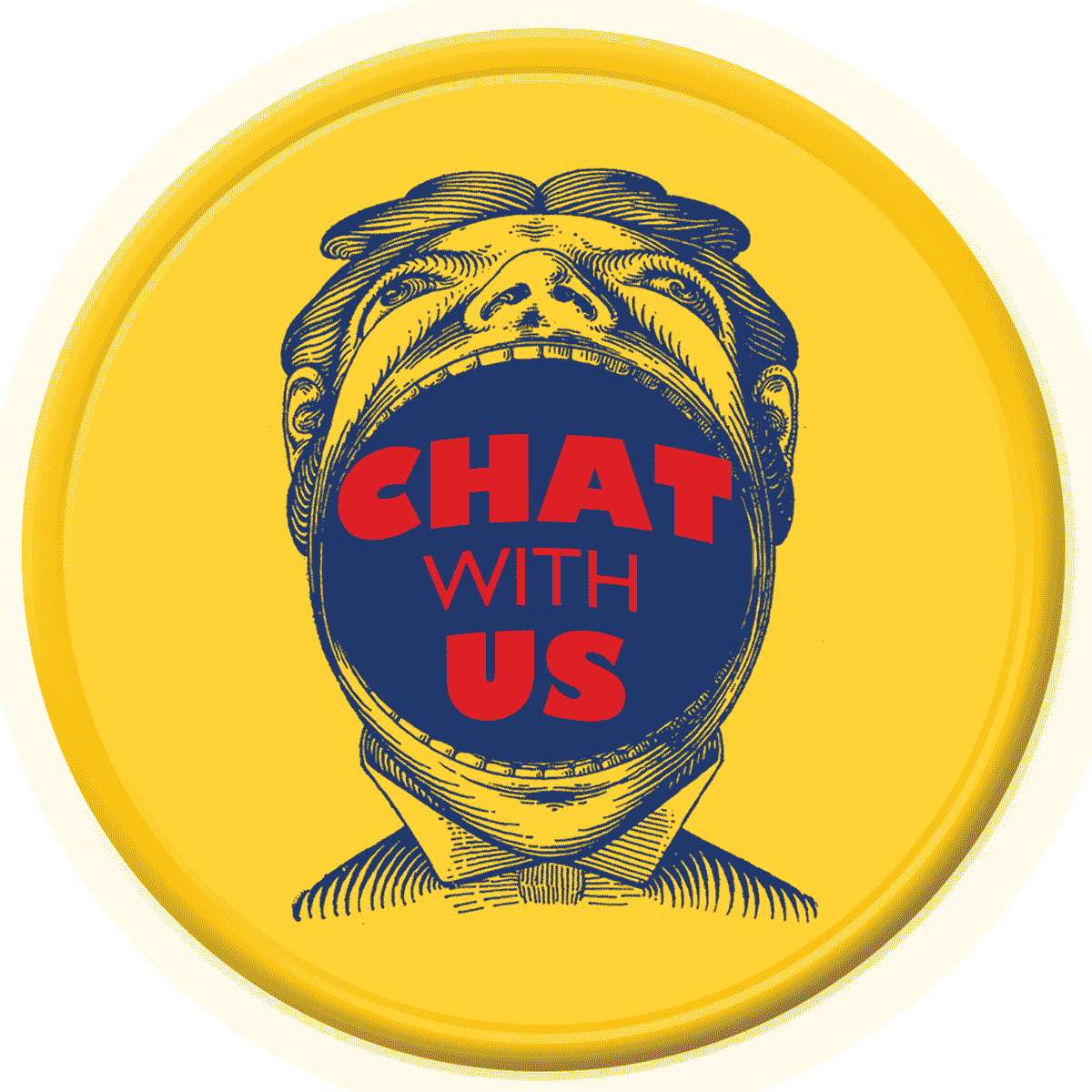
Have a cooking question, query, or quagmire you’d like Renee and David to answer? Click that big-mouth button to the right to leave us a recorded message. Just enter your name and email address, press record, and talk away. We’ll definitely get back to you. And who knows? Maybe you’ll be featured on the show!
Transcript
David Leite: Renee, do you have a favorite knife?
Renee Schettler: I have a confession to make…
David: Oh my God, more confessions. You don’t have knives.
Renee: I have one knife.
David: No! You’re like my mother!
Renee: No, I’m NOT like your mother, with all due respect to Momma Leite. I have a very spare kitchen aesthetic and I’ve been searching and searching for the right knife for a long time. And so I’ll buy one of a particular brand—my current one is Schmidt Brothers—and I just kind of see how it works for me. Because it’s not just how sharp it is, it’s how it feels in your hand…
David: Absolutely, very good point…
Renee: … how it looks on the rack…
David: …the balance. Everything.
Renee: Absolutely.
David: So you do everything—chopping, slicing onions and garlic, cutting up turkey, cutting up chicken—with that one knife?
Renee: With that one knife.
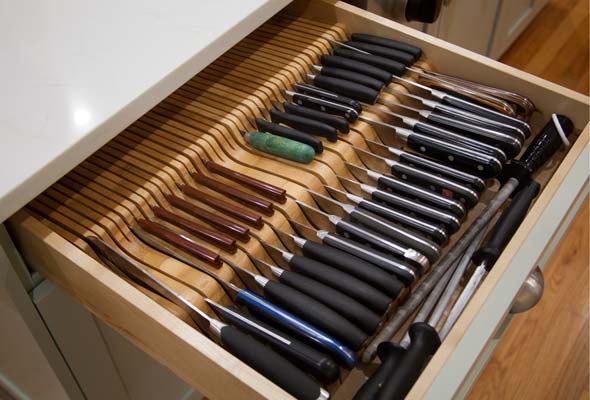
David: Wow. See, I have probably about…I don’t know…30 knives. Probably about–
Renee: 30?
David: Yeah. But about 25 of them I don’t use. Truly. But we just keep on buying knives or people gift knives to me. But my favorite, though, I have to say my favorite is a knife that’s older than me. I think it’s 61 years old. And it was given to me by friends of my mom and dad. He was a chef at this restaurant in Fall River, Massachusetts, a diner really, called Nite Owl. And it’s an old carbon steel chef’s knife. It’s very long. It’s very stained. It’s so marvelous. The thing is, I don’t want to use it very often, because it’s just so beautifully patinaed and it has such special meaning to my mom and my dad. But that’s, I think, my most treasured knife at the moment.
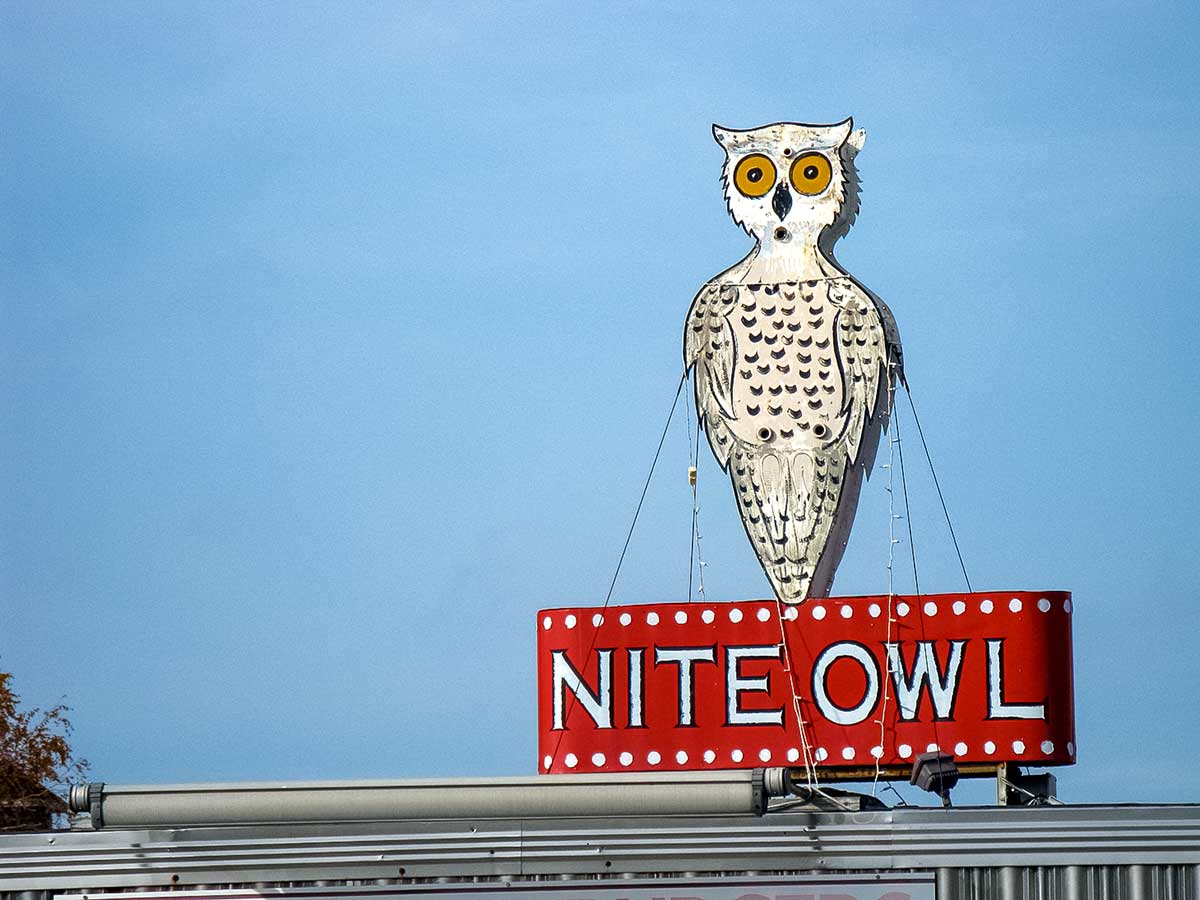
Renee: I can understand that. I mean, I’ve actually spent hours looking on Etsy for knives. Knives with that character. But I can’t ever bring myself to purchase it, because the story behind that knife is not mine.
David: Yes, exactly. And I’m co-opting this gentleman’s story, but the fact that he handed it down to me when he was done…
Renee: That’s fair.
David: It is. That’s very special. Hi, I’m David Leite, founder of the website Leite’s Culinaria.
Renee: And I’m Renee Schettler, the site’s editor in chief.
Quinton Middleton

David: And this is Talking With My Mouth Full. Today Renee and I have a guest on the show that we’re so, so proud to have on. His name is Quintin Middleton and he is an exquisite knife maker outside of Charleston, South Carolina. His company is called Middleton Made Knives, and they are something to behold. They’re beautiful. They’re well balanced. They have an incredible blade design and they were designed, really, for chefs and also home cooks. What I think is important about this interview is not just the knives, but the man, and the story behind the man and the knives. Welcome to the show, Quintin.
Renee: We’re glad you’re here.
Quintin Middleton: Thank you for having me, I really appreciate it.
When did you know you wanted to make knives?
Renee: So Quintin, making knives isn’t exactly a common career choice.
Quintin: No, not at all.
Renee: How did that come to be?

Quintin: Well, it kind of started from me watching movies like Star Wars…Conan…
Conan: Look out!
Quintin: I’m an ’80s baby.
David: Right.
Renee: Nice.
Quintin: Those movies like that kind of peaked my interest. And I would take tubing off my swing set, and I would take a cinder block and a hammer, and I would hammer it flat, and…
Renee: Oh my god.
David: Wait a minute. You would take the tubing off a swing set?!
Quintin: Yeah.
David: What did your mother and father think?
Quintin: Oh, they did not like that one bit, not one bit at all.
Renee: Wait, did you have siblings that were on the swing set while you were disassembling it?
Quintin: Well, I have two older brothers and a younger brother. So my older brother would fight with me and I would take my whatever I would made then and be like…[warrier cry]!
Renee: That’s great.
David: Wow.
Quintin: My younger brother is traumatized now. Still.
Renee: They learned not to mess with you, though.
Quintin: Exactly.

Quintin: While I was in school to be a mechanic, I worked in this mall, a local mall, and I was selling knives, pocket knives, and cigars. It was called Outman Knife & Cigars. This guy, this burly guy, came in there one day like, “Hey, I make knives for a living.” And my eyes just lit up. I was like, “Can you teach me?”
Renee: That’s when you know.
Quintin: Yes.
Renee: Nice.

David: So that was Jason Knight?
Quintin: Yes. It was Jason Knight. So he came in with his beard and everything. And he came in like—Jason talks with his hands like how I do—so, “Hey!” And he kind of took me on, I was maybe 17, 18.
Renee: Wow.
Quintin: I was his apprentice for maybe six years.
How divine intervention played a role in Quintin’s calling
David: You were making, if I’m not mistaken, Jason makes hunting knives…
Quintin: Yes. He made hunting knives, bowie knives, swords. And I was doing the same thing. I wanted to be just like him. But I had a dream. The Holy Ghost or God or the divine spirit told me to make chef’s knives.
David: Really?
Quintin: Yes.
David: Wow.
Renee: Can you tell us a little more about that?
Quintin: Yes. My whole dream after seeing Jason have the freedom of being a knife maker and providing for his family, I was saying, “Wow. I want to do the same thing.” He kind of has that outdoor tactical thing locked down in the area. So I was like, Lord…I’m praying…I said, “Lord, I need you to make a way for me. I need you to do something for me. I need you to guide me and direct me on the things, what I should do.” And when I was getting up out of my dream or waking up, a loud voice say, “Make chef knives.”
Renee: There you have it.
David: I have to tell you, I’m getting goosebumps.
Quintin: Wow.
David: I’m getting goosebumps as you tell the story. I mean, talk about divine intervention, doing what you’re meant to do. That’s astounding.
Persistence and practice make a dream career happen
Quintin: Yes. But still, even though I have…anybody can tell you where to go and how to go on or what to do, but you still got to go down the road.
David: Yeah.
Renee: Absolutely.
Quintin: So I had the direction, I had where I need to go, now I need to know how to get there. So I made a long list of every top chef in Charleston, I called every last one of them. And every last one of them turned me down.
David: Really?
Renee: No.
Quintin: Yeah. Sean Brock. All these high-end chefs turned me down. But if I were to call you and say like, “Hey, would you buy some knives?” You’re more likely to say, “No, get out of here. I don’t want to…”
David: I would think you’re selling Ginsu knives or something.
Quintin: Yeah, exactly.
Renee: So that didn’t stop you.
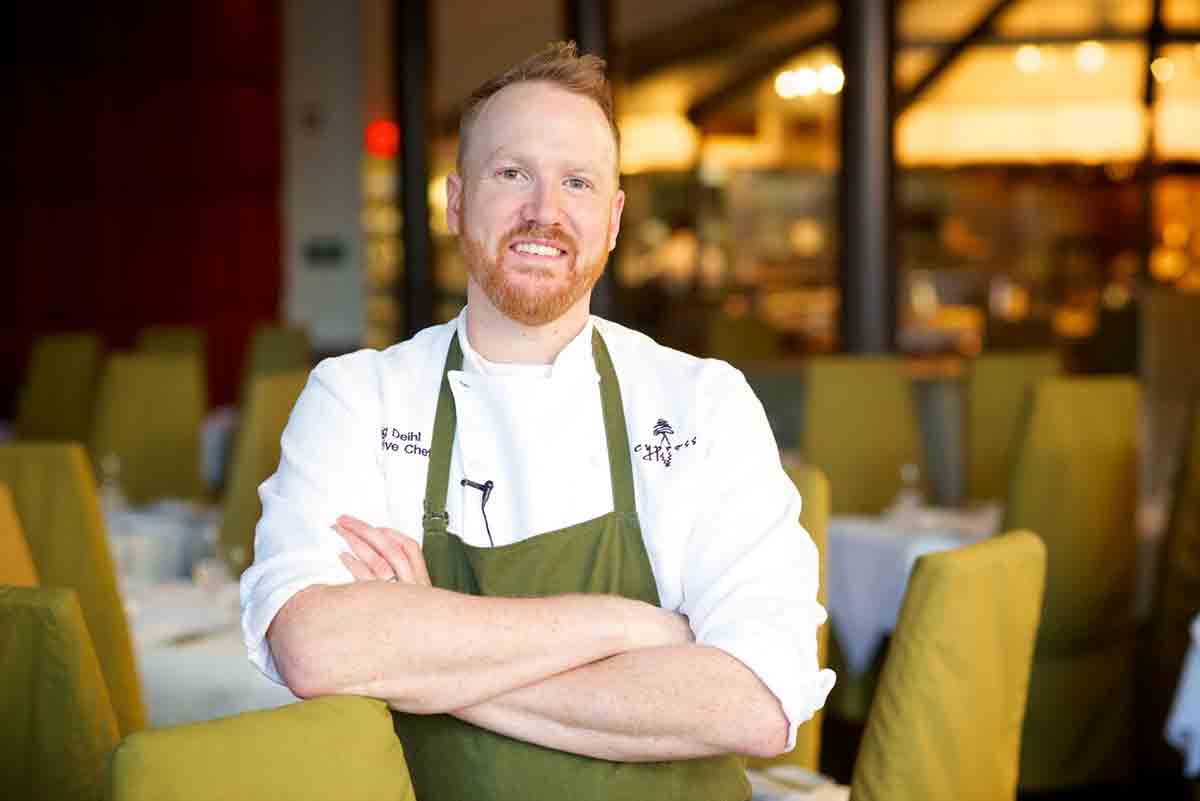
Quintin: No, it didn’t. While I had maybe about 30 people on my list, I called this individual, his name is Craig Deihl. He was a chef at this restaurant called Cypress. That same feeling or notion or the Holy Ghost leading me, he told me to call him back and ask him, “Can you help me develop a knife?”
David: Wow.
Quintin: So I called him back that same day. I said, “I just called you, and I just talked to you, and I was wondering, can you help me develop a knife?”
Renee: Beautiful.
Quintin: “…or something that you would want to use in your kitchen?” He said, “Of course. Come by today.”
David: Wow.
Quintin: I went by there, and here’s the funny part of that story, too. I went by there and the knives that I thought would be perfect for chefs, all his sous chefs and line cooks that came around, “Oh, this is cool.” I’m thinking I’m going to leave here with maybe like $500 or something. Somebody’s going to buy something. And every last one of them put it down and walked away. I was kind of shot down. Craig came to me and said, “Okay, these knives are cool, but I can’t really use them because they’re too heavy. They’re too clunky. They’re like a bush knife or a hunting knife.” Because that’s what I’ve been making.
David: That’s your background. Of course.
Renee: Of course.
Quintin: He would say, “Okay, I need you to make a chef’s knife and I need you to make it this thin. I need you to make it this long.” So he would give me tidbits.
Renee: That’s it.
Quintin: From him giving me tidbits, I would go and make it with the advice he gave me. And I would bring it back. He loved it. He told friends, their friends told their friends, somebody told Emeril Lagasse, and…
Renee: Wow.
David: That’s it.
Quintin: Yeah, it just blew up.
David: And how long have you been making culinary knives?
Quintin: I’ve been making culinary knives for 10 years. I’ve been making knives in general for 17 years.
David: Okay.
How do you make those crazy gorgeous handles on your knives?!
Renee: And over that time, what have you kind of learned in addition to what you learned that first afternoon?
Quintin: Wow.
Renee: In terms of what chefs…
Quintin: Chefs want.
Renee: Yeah.
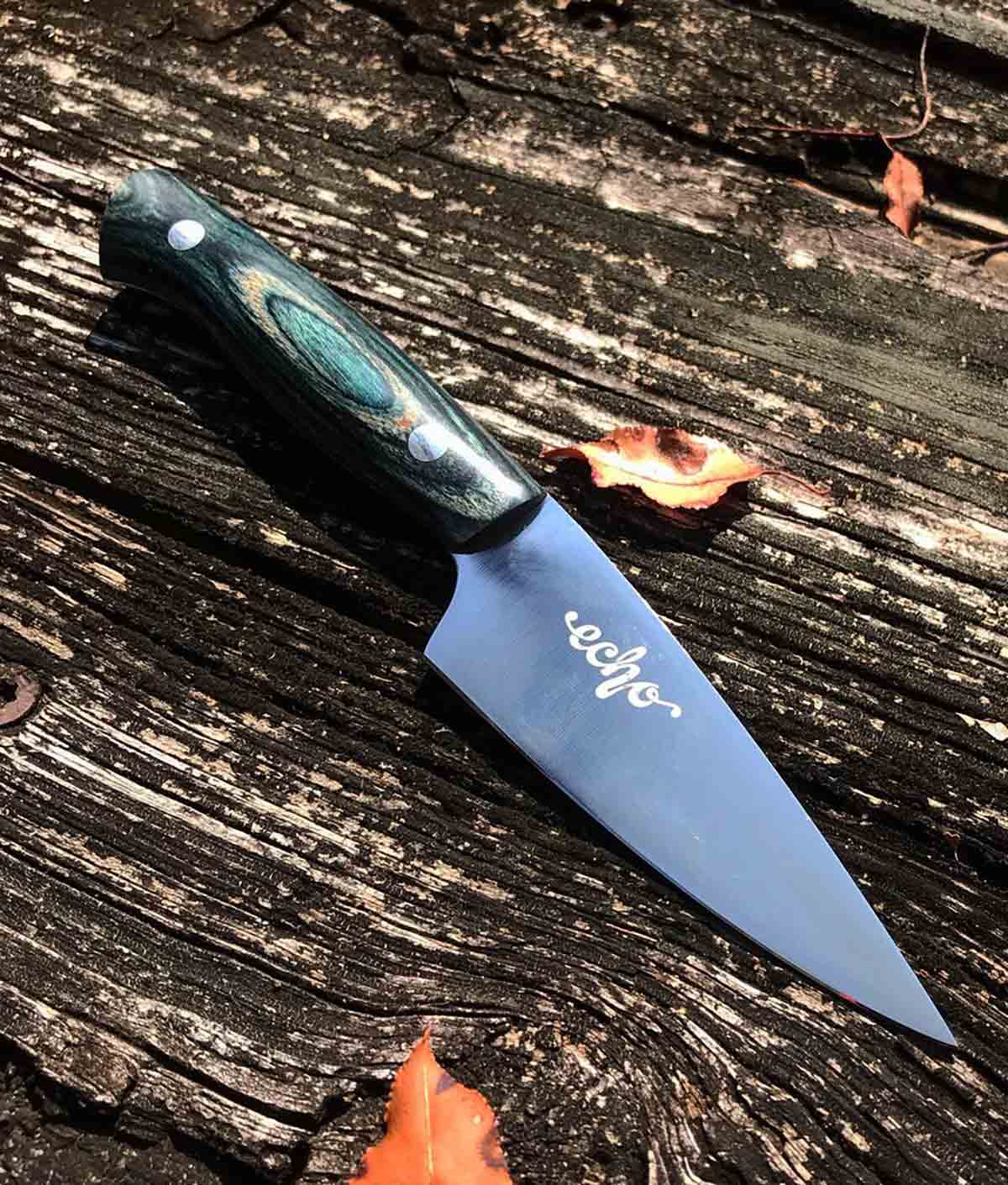
Quintin: What he told me after watching him work in his kitchen, and countless others—I’ve been in McCrady’s and a lot of the high-end restaurants in Charleston, I was basically standing in the corner and I would watch the line cooks work and prep. I would see how they move, how they hold themselves. From that, it was…I remember this very vividly…one of my friends, his name is Bob Cook, and he was the sous-chef for Craig. He was cutting up garlic and he had this very narrow paring knife. And I was saying, “Why can’t that knife be wide. Why can it be a little longer?” So I said, “Well, I’m going to make something for him.” I made something for him, he loved it. And that’s my paring knives now.
David: Excellent.
Renee: Wonderful. I’ve seen the handles, I’ve seen, you have this amazing video on your…
Quintin: Website.
Renee: …website where you talk specifically about the ergonomic nature of the handles. Because that’s often my complaint about a knife as you grab it. It’ll do the job, but it just doesn’t feel like it belongs in your hand.
Quintin: Correct, yes. I’m all about comfort. The knife can look good and it does what you say it’s going to do, but when you work with it, it’s a chore. You’re not happy with it. It’s just like, “Okay, I’m going to cut something and that’s it.” But when it becomes an extension of yourself, you’re just like, “Wow, I’m enjoying this.” Now you can sip wine and talk with your girlfriends or your homeboys and make them jealous because you’ve got something cool.
David: I read somewhere that you said, and forgive me, I’m really messing this quote up, but you want your knife to work for you, you don’t want to have to work for the knife.
Quintin: Yeah. Basically it’s saying, I want you to use the knife instead of the knife using you.
David: There you go.
Renee: That’s it.
David: That’s it. And I thought it was great because you also talked about the knife being an extension of your hand. Which I thought was really a beautiful way of looking at what you do with a knife. Because a knife, after a lot of cutting, you can get really weary.
Quintin: Yes. So when I kind of explained that to somebody, I would tell them, “Okay, let me explain what I mean. If you take your finger and you point your finger out, your finger doesn’t feel heavy. Your finger doesn’t feel like it’s weird. It’s a part of you. Your knife needs to be the same way. If you put your finger on the dot, it’s there, it’s very precise. So your knife needs to be able to do the same exact thing. It needs to go exactly where you put it.”
Renee: I love that. I love that you studied the way chefs move in the kitchen. I mean, have you noticed how you navigate the kitchen and your own cutting boards? Do you cook a lot?
Quintin: Yes. My mom has all boys, so she says she’s not going to be cooking all her life, so…
Renee: So she taught you to cook?
Quintin: She taught all of us how to cook, actually. My younger brother is actually a professional chef.
Renee: Translating knives from the home kitchen to the chef’s kitchen, what is it that makes the perfect chef’s knife?
Quintin: So, I suggest the eight-inch chef knife and a lot of my knives, the handle is almost shaped like a Coke bottle. So when you grab a hold of it, the bulby part fits in this part right here. Where your pinky and thumb is, it kind of caresses the knife and it fits just right. Right above where the blade is, there’s a notch where your…if you got a pinch grip, your middle finger will get in that groove. Every part of my knife has a place for your hand to go and it just feel comfortable.
Renee: Nice.
David: You can choke the blade then, easily with no problem.
Quintin: Yes.
David: Good. I do choke, I don’t know why I’ve always done that. I’ve always choked the blade. You know what that means, Renee, to choke the blade?
Quintin: Your fingers are all the way up on it.
David: Exactly. That’s what that means, Renee. It’s all the way up on the top.
Renee: David’s usually got to be all up into everyone’s business…so it’s no surprise to me.
David: I am always in everyone’s…and here I am mansplaining to Renee what a choke is. That’s great, mansplaining on the podcast. So what kind of materials do you use for your handles? Because they’re gorgeous and there’s an Instagram post here where you have three different pieces of wood, gorgeous burled wood. A green, and also this purpley blue, and this crazy-ass zigzag design on the knife, which I want to talk about in a minute.
Renee: The engraving, the etching on the knives is exquisite.
Quintin: Thank you.
David: Yeah. Let’s talk about the handles first. What materials do you use for the handles?
Quintin: I use countless materials, but I like to use maple burl. Maple burl that’s the knots and the figuring inside the wood. And I dye them different colors, like the purple that you saw on that post. There was one that’s in the middle, that was a green. That was from a curly maple where you see the waves in it. The brown one was desert ironwood, and it’s from Arizona, it’s a very dense, strong wood. And out of those three, the purple is winning. So I’ll be making the purple handle on that knife.
David: That was what I voted for. I thought it’d be great, I thought it’d be wonderful.
Renee: I’m from Arizona, so I’m partial to the ironwood. But they’re each extraordinary.
And then there are those exquisitely designed blades…
David: And talk to us about this crazy, incredible zigzag design that you have. What is that?
Quintin: It’s called Damascus, or pattern-welded steel. What it is is two different types of steel, alternating in layers. And once you forge-weld it, or putting in a forge, and you heating it up to around 2300 degrees. Either you’re hitting it with a hammer or using a hydraulic press that compress it down to make it a little bit more manageable. And we have different jigs that looked like zigzags, so it kind of bites into the metal. That’s where you’re seeing the zigzags in it. How you will see it a little bit more, there’s a core. I will have alternating layers on the outside and a big solid piece in the middle and another alternating layers on the other side. So when I compress it, and you bite into it, then that’s how you see the zigzags in it. It’s a lot of science. Or ideas.
Renee: All of your designs, though. I mean, where do you get the ideas for these designs? I’ve seen these exquisite swirls. I’ve seen all kinds of patterns and they just, you make it look easy. It looks like you just started sketching.
Quintin: Well, I could say, I invented it myself. I really could! “It just came to me!” But no, it’s a process that you learn when you start learning how to make Damascus. The patterns that I use is very simple. Even my knives, it’s a very simple design, but it’s effective, if you know what I mean. I don’t want to put too much embellishments on it, because it takes away from what a knife is really used for. Because I can make a knife that’s very elaborate, I can put ivory on it, mammoth ivory, let me clarify. I could put, all kinds of stuff to make it very fancy. Then someone really wouldn’t want to use the knife. They just want to hang it up and put it on the wall. And I’m fine with that too, but my knives are made to be used.
David: Right.
Renee: I have to admit, I was kind of thinking that as I looked at your knives. I was trying to select one and I’m like, “I don’t know if I can actually use it, I think I’m just going to hang it up.”
David: I can’t wait to get mine and use it. I’m going to order one right after this.
Quintin: Well, I am ready for you, sir.
David: Thank you.
Renee: So all of these are handcrafted.
Quintin: Yes.
David: And where do you make your knives?
Quintin: Actually, it’s right on the other side of this wall.
David: Really? In your house?
Quintin: But this is my office, actually. So I have a 1,000-square-foot shop right next to my office, this is about 400 square feet office. My house is a little further up. My wife told me I couldn’t bring any more knives in the house.
Renee: She doesn’t want to hear you clanging and banging through the walls.
Quintin: Yes, exactly. She said, “You need to go outside.”
The real story behind the man who makes the knives
David: How many people do you have working with you?
Quintin: I have currently three people working for me. And that’s really amazing to say. Wow. Three people working for me.
David: Congratulations.
Quintin: Thank you.
David: From an idea and a dream to having a staff.
Quintin: Exactly.
David: Congratulations.
Renee: And that’s so much more satisfying to your soul.
Quintin: It is. I’ve worked jobs where I really wasn’t happy. I had to work because I had to work. I’m married and have two children and working little jobs, I wasn’t really satisfied or feel accomplished in anything. So when God told me to make chef knives and my wife telling me, I remember this day vividly, I got fired from a job. I was working a little dead-end job, probably making $200 a week. We just had our second child, my daughter. And the daycare was $240. And I’m barely made that.
Renee: Wow.
David: Wow.
Quintin: And my wife, I just laid my head on her lap and said, “Babe, as a man, I feel so helpless right now. Because I don’t know what can I do? Because I’m not used to being in this position.” She told me, “Follow your dreams and God will make a way.” And here I am.
Renee: Beautiful.
David: Wow. That is incredible.
Renee: I love that she supports you that way.
Quintin: Yeah.
David: Really very touching.
Quintin: Yeah. The whole idea of that is, I want to build something for my family, build something for my children. Something that they can carry on. They don’t have to be the grump that I am. I always tell them, “Let daddy be the grump. I want you to be the CEO. I want you to use your brains.”
David: See, what’s wonderful is that the knives are far more than just knives now, they’re tools for chefs. They’re tools to make people’s lives easier. But there’s something that has worked for you to transform your life, transform your family, and transform the future of your children. And that’s extraordinary.
Quintin: Thank you.
David: And I am so incredibly moved to hear that.
Quintin: Wow.
David: I’m honored to be able to have you on the show to tell your story…
Quintin: Thank you.
David: …which is far more than knives.
Quintin: Yeah, it’s way more…
Renee: So much more.
Quintin: It’s way more than knives. Actually, and from day one that…when I said I had three employees, though from day one, I wanted to hire people from my community and kind of breathe life back into their American dream. So the American dream has so many…it means different things for different people…
Renee: Sure.

Photo: Quintin Middleton
Quintin: But for me is to be able to provide for my family, provide a great life for my children, and something where my children can look back and say, “I am proud of my dad.”
David: That’s wonderful.
Quintin: Thank you.
David: That is truly wonderful. I want to get back to one question that our readers and our users…I’m getting so verklempt…I want to get back to a question about knives from our listeners and our readers is, many of them don’t know how to sharpen their own knives, me included. Do you think it’s best to get one of those sharpeners at home or to have them professionally sharpened?
Quintin: If you’re getting knives from a lot of those bigger stores, of course, use what you can to get it sharp. But if you’re spending the money to get something custom or produced by a knife maker, either send it back to the knife maker or give it to someone that you’re comfortable allowing them to sharpen the knife.
David: When I buy my knife from you, I would ship it back to you to get it sharpened.
Quintin: Yes, you can. I tell people, even when I do festivals, this is not the end of the relationship. This is not the end of the transaction. We’re going to always be rotating back, because eventually within a year or so, you’re going to want your knife sharpened. Or you want to kind of get the knife back his luster, the way when you first bought it. You can’t take that to just anybody to do.
David: Excellent. Well, Quintin, thank you so much for coming on the show and opening our minds and our hearts to your product and also your story.
Renee: Quintin, thank you for bringing some beauty, in addition to all the beauty that David mentioned earlier. It’s just a reminder that every day there can be art, there can be beauty, creativity.
Quintin: Yeah, exactly. You have to look beyond what your eyes see. And this is a ministry for me.
David: It is. Well, thank you.
Quintin: Thank you.
David: You could find Quintin and his gorgeous knives at middletonmadeknives.com, where you can purchase them. And I really hope that you will. As well as on Instagram at @middletonmadeknives.
Recipes on LC’s specials board this week
Chef in the Kitchen: Hey, it’s a chop, a chopity chop.
David: Well, Renee, you know it’s that time, the end of the show. Can you please tell us what is on the special’s board?
Renee: I can. Well, it’s mid-summer, so of course we have peaches…
David: Peaches.
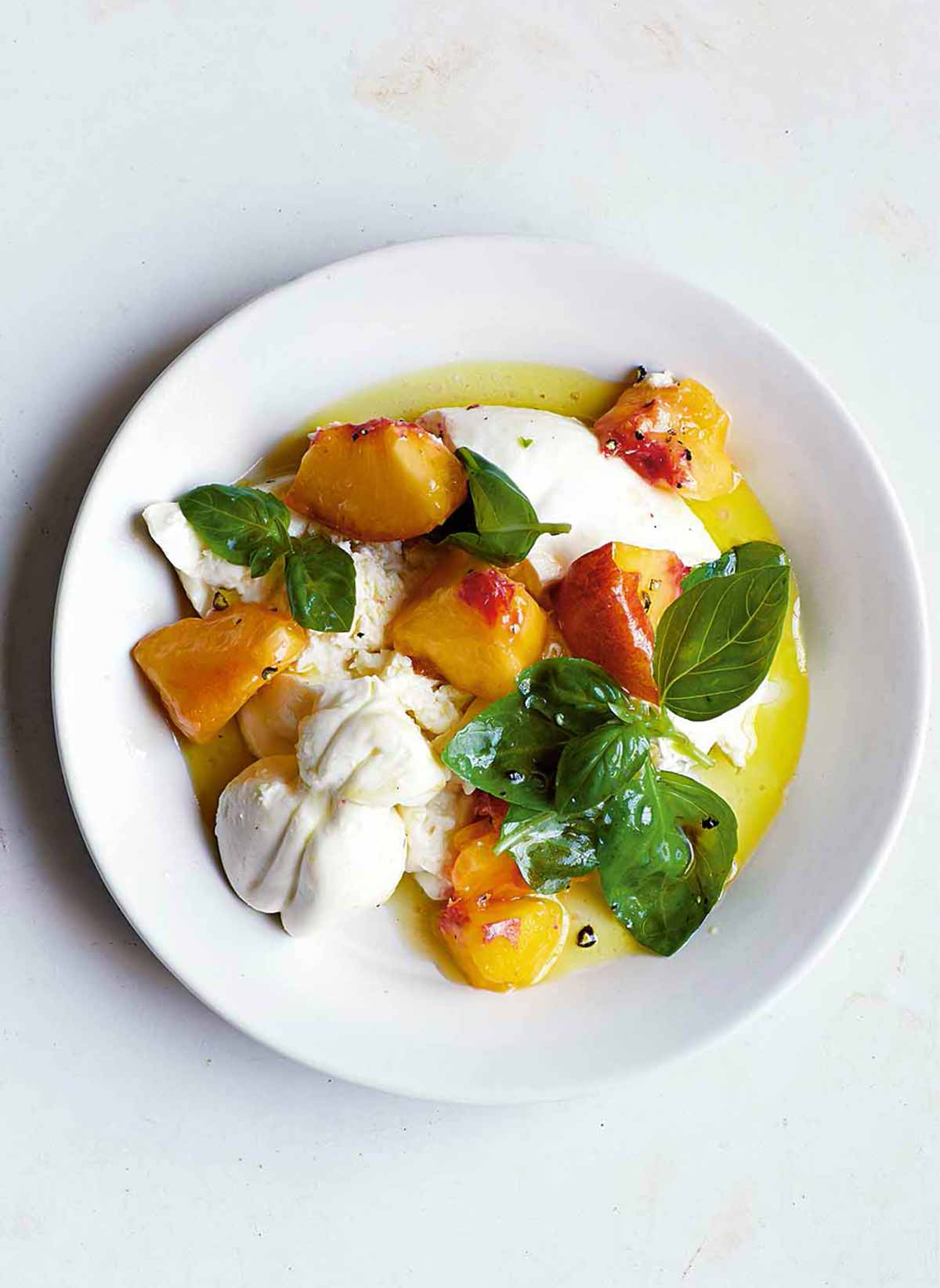
Renee: …every which way, including a peach, burrata, and basil salad. Which is so easy to come together. It’s basically cutting board cuisine, there’s no stovetop involved. So exquisite. So rich. We also, speaking of rich, have chorizo breakfast tacos. Forget breakfast burritos today, we’re going tacos. So they call for eggs—sunny side up, not scrambled—and that rich, flavorful, slightly spicy chorizo, so satisfying. You’re going to want these anytime of day.
David: I may want to use Portuguese chouriço in place of chorizo.
Renee: You can do that, just don’t tell me.
David: I won’t tell the Spaniards, either.
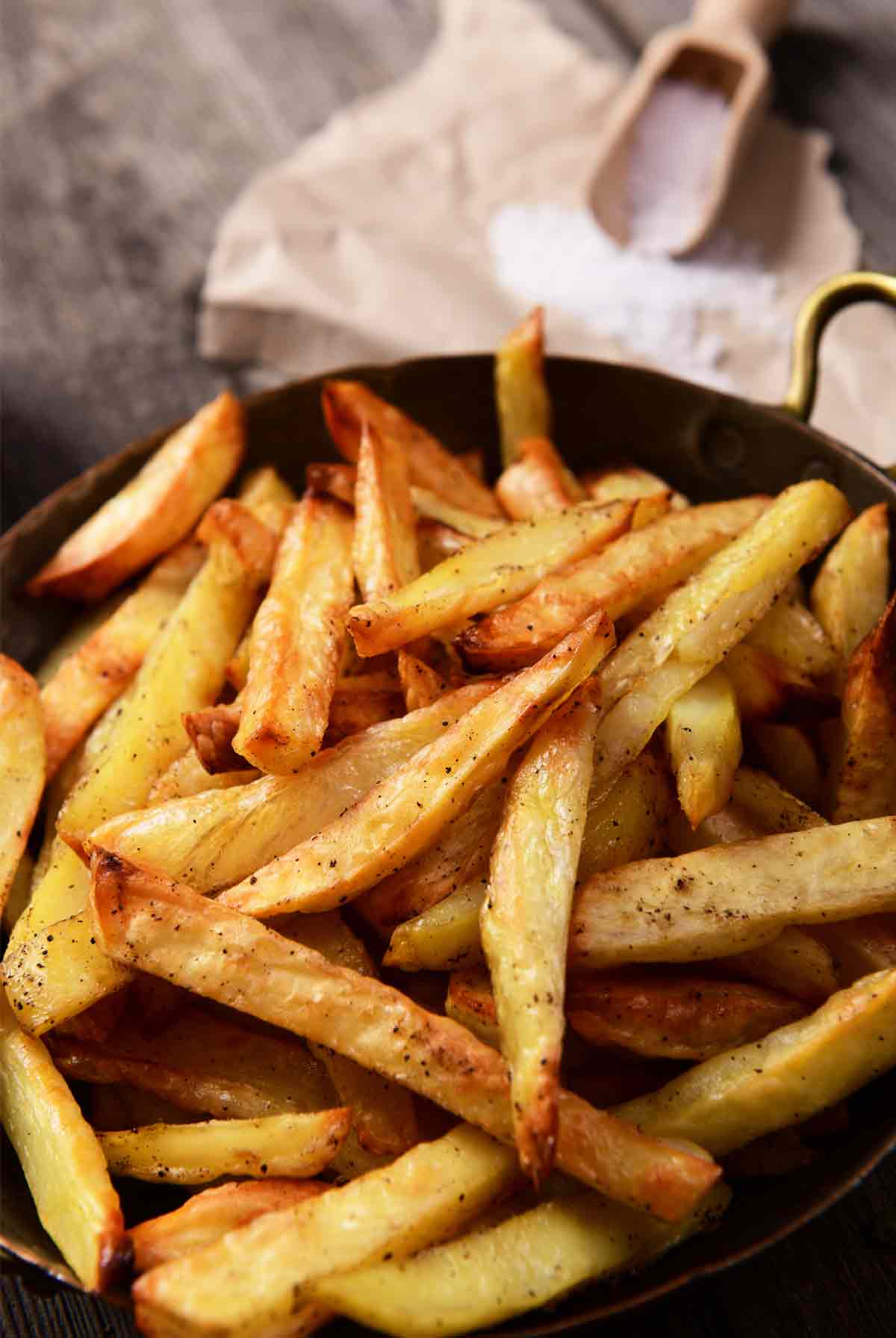
Renee: We also tell you how to make the perfect French fries. A lot of people promise you this. We deliver.
David: Double fry?
Renee: Absolutely.
David: Lower temperature, higher temperature?
Renee: You got it.
David: It’s the way to go.
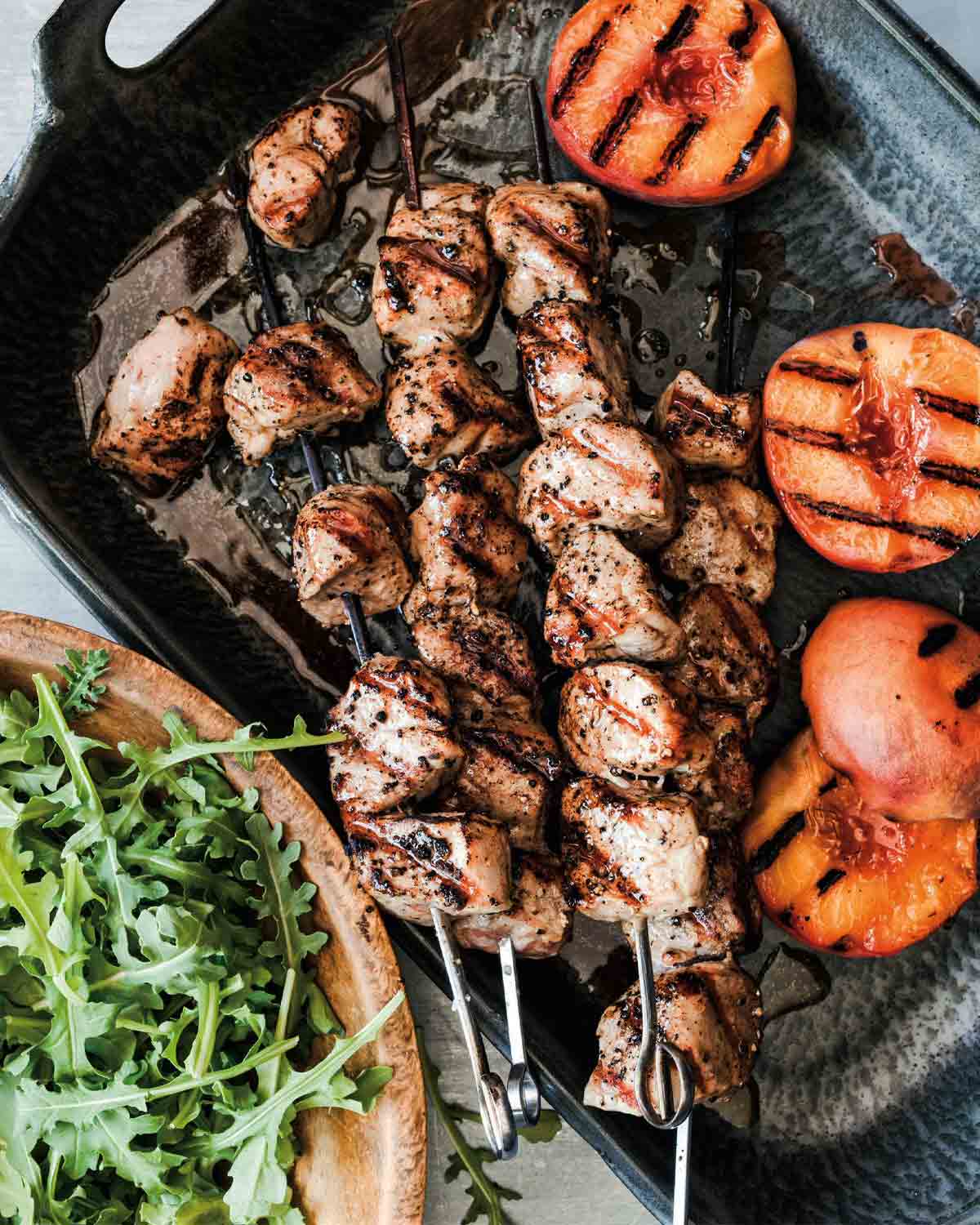
Renee: Skin on the ends if you want. Okay. We also take peaches in a different direction. We’ve got grilled pork skewers with peaches.
David: Lovely. Nice combo.
Renee: Peaches, perfect. And then we wrap it up with an apricot galette. Maybe you’re scared of making pies. Galette is like a cheater’s pie, where you only have to deal with one crust and you don’t have to worry about transferring it into the pie dish. You don’t have to worry about crimping the edges or fluting them or crisscrossing the lattice top. You just kind of plop the filling in the middle and you roll the dough up and over the sides. That’s it. So easy.
David: The uglier it is, the prettier it is, really.
Renee: Rustic is, I believe, the term we use.
David: That’s what we’re calling it these days, rustic.
Renee: We’re calling it rustic, yeah.
David: This podcast is produced by Overit Studios, and our producer is the razor sharp-witted, Adam Clairmont. You can reach Adam and Overit Studios at overitstudios.com. Remember to subscribe to Talking With My Mouth Full wherever you download your favorite podcasts. And if you like what you hear and want to support us, leave a review and rating on Apple Podcasts. Chow!
Renee: Chow!
Oops…OUTTAKES!
David: Renee, do you have a FAFE…(gags and stumbles over his word). That’s an outtake, Adam, so you can use that. All right, you’ve got to save them.
Renee: No, I don’t have one of those, David.
David: You don’t have one of those, okay. Try it again.
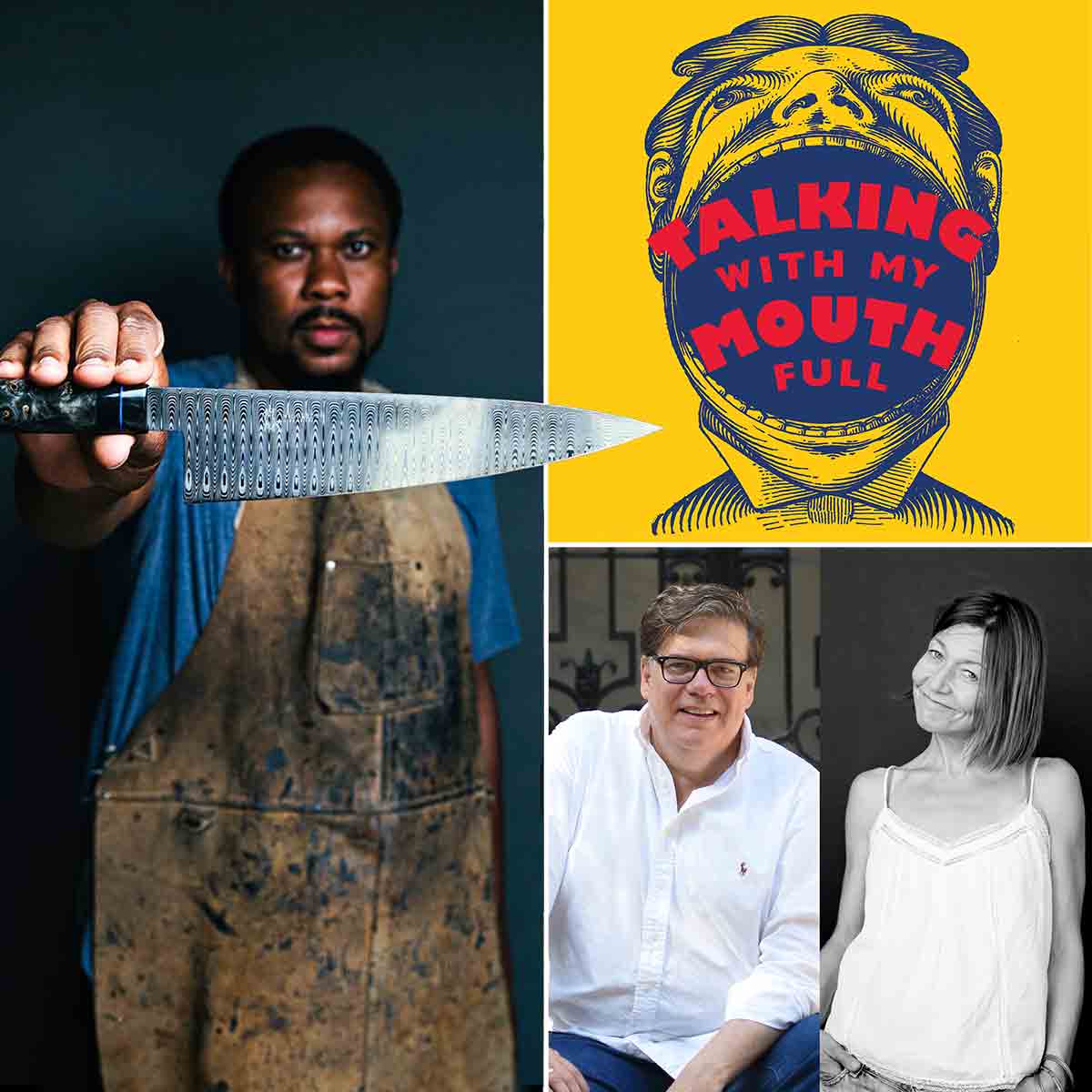

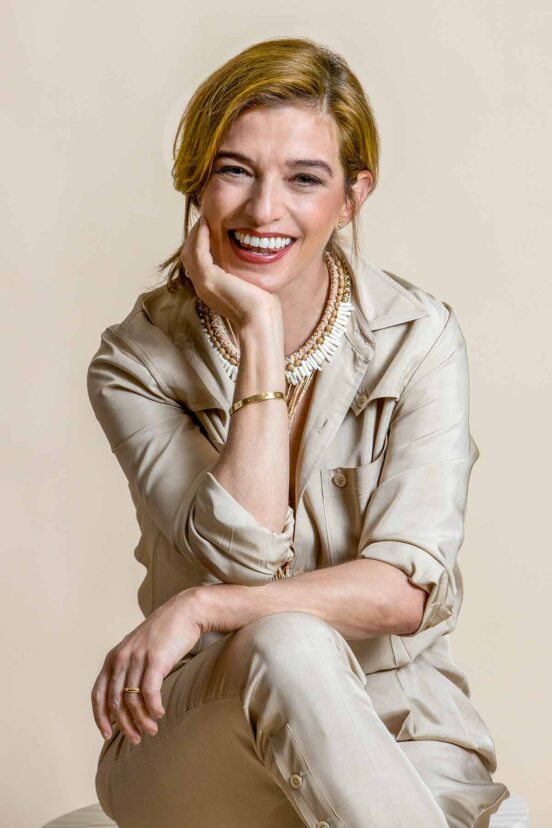
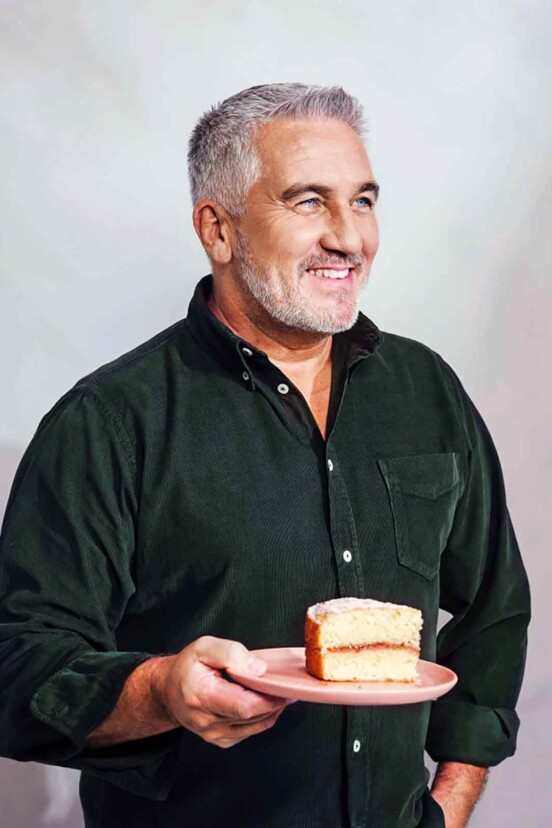
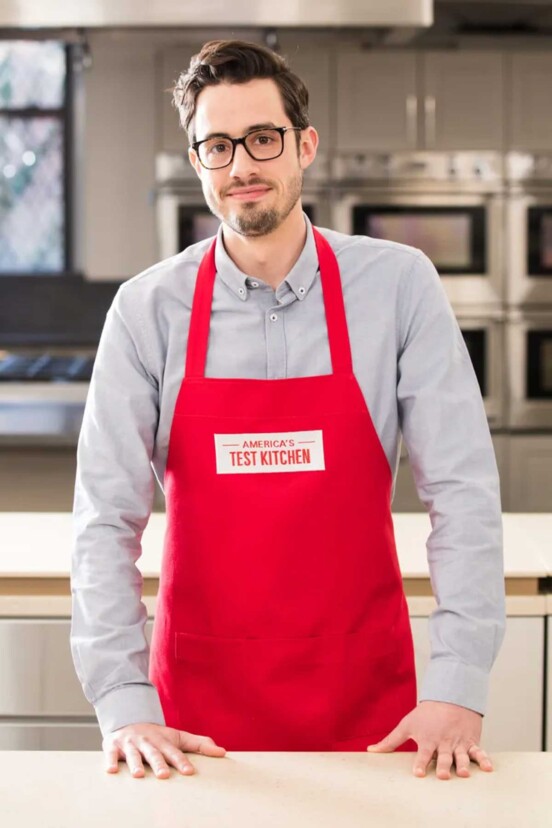









Wow! Beautiful knives! Love how beautiful and functional the knife is.
They are exactly that, Lisette! We hope you’ll consider getting yourself one. It’ll last forever. And it brings such beauty to your kitchen…
As always I was both entertained and informed. I have been agonizing over knives and it’s amazing that this just popped popped up on my radar ❤️
Thanks, Lisa! We hope this makes the decision easier.
Dear David love your blog. Have you ever tried Puerto Rican food?
Luis, I have. I’ve been to Puerto Rico several times on food trips. Loved the Ruta de Lechon! And a dear friend is Puerto Rican and he has cooked for us, too.